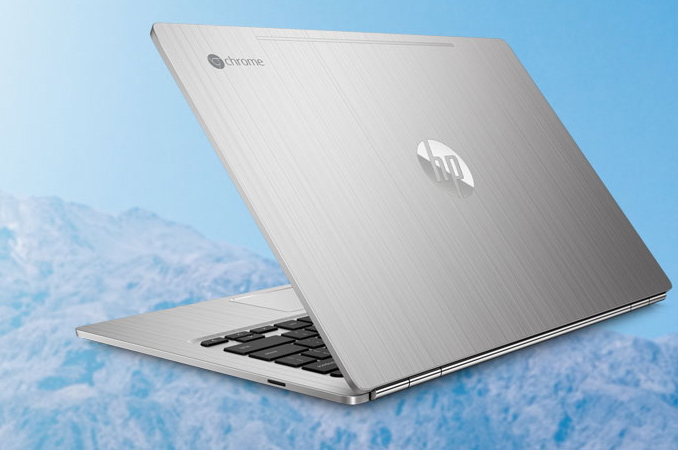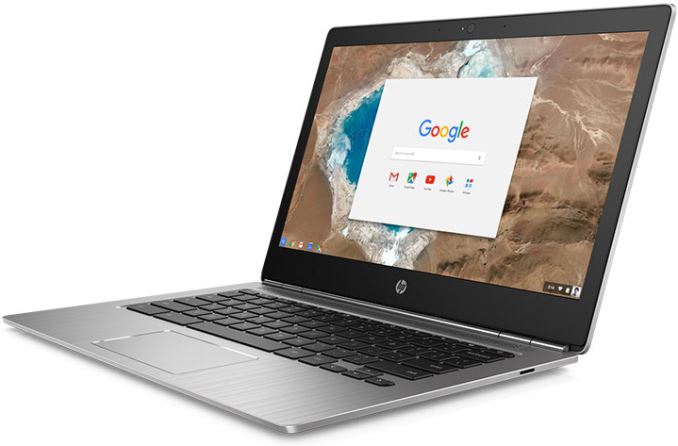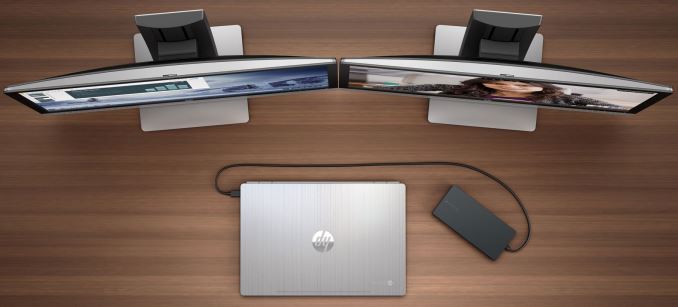HP Unveils Premium Chromebook: 3K Display, Intel Core M, 16 GB of RAM and USB-C
by Anton Shilov on May 3, 2016 8:00 AM EST
HP has announced a new family of Chromebooks, which are powered by Intel’s high-performance processors and feature stylish design, aluminum body, high-resolution display and even Bang & Olufsen speakers. The new laptops will not be as affordable as many other mobile PCs running Google Chrome OS and will not be as powerful as Google’s Pixel, however, this is what HP believes to be the right balance between performance, style, portability and price.
When Acer and Samsung introduced their first notebooks based on Google’s Chrome OS in mid-2011, they praised their low price and mainstream computing capabilities. At the time, Chrome OS was a mystery for most people, netbooks were relatively popular and it made sense for the aforementioned PC makers and Google to address the entry-level segment of the market with something very affordable. As Chrome OS gained traction, PC makers began to install higher-performing components into their Chromebooks. However, they were still not ready to address the high-end market segment with such PCs, which is why Google released its Pixel laptop in 2013. The Chromebook Pixel is one the most advanced and stylish Chromebooks ever made because of its Core i7 “Broadwell” CPU, a display with 2560×1700 resolution and 3:2 aspect ratio. But, the Pixel costs $999 and not all users are ready to invest that sum in a Chromebook. Fortunately, different PC makers offer various systems that attempt to replicate some of the Pixel’s features. HP decided to build its own competitor for Google’s Pixel and while the product is not exactly affordable, it has a better screen than most Chromebooks and a number of other advanced features.
The HP Chromebook 13 sports a 13.3” IPS display with 3200×1800 resolution (QHD+), 170-degree viewing angles and 16:9 aspect ratio, which is good for multimedia applications and video. HP’s latest Chromebook comes in brushed anodized aluminum chassis, it is 12.9 mm thick and weighs 1.29 kilograms (2.86 pounds), which is thinner and lighter than Apple’s MacBook Air 13”. Despite the very high resolution screen, the laptop works up to 11.5 hours on one charge of its 45 Wh battery, according to the manufacturer.
To enable long battery life, HP used Intel’s Skylake-Y system-on-chips to build its Chromebook 13. Various versions of the system are powered by either Pentium or Core M SoCs with two cores, Intel’s HD Graphics 515 (Gen9) core with 24 EUs (execution units) as well as 6W or 4.5W TDP. The system will likely be considerably faster than other Chromebooks running Atom, Celeron or Pentium processors because of the high-performance CPU architecture.
| HP Chromebook 13 Specifications | |||||
| Screen Resolution | 3200×1800 | ||||
| CPU | Intel Core m7-6Y75 | Intel Core m5-6Y57 | Intel Core m3-6Y30 | Intel Pentium 4405Y | |
| Graphics | Intel HD Graphics 515 (Gen9, 24 execution units) | ||||
| RAM | 16 GB | 8 GB | 4 GB | ||
| Storage | NAND flash storage | ||||
| Wi-Fi | 2x2 MIMO 802.11ac Wi-Fi module (?) | ||||
| Bluetooth | Bluetooth 4.2 (?) | ||||
| USB | 2×USB-C, 1×USB-A ports | ||||
| Other I/O | Microphone, stereo speakers, audio jack | ||||
| Thickness | 12.9 mm/0.5 inch | ||||
| Weight | 1.29 kilograms / 2.86 pounds | ||||
| Price | $1029 | $819 | $599 | $499 | |
Depending on the model and price, the HP Chromebook 13 can be equipped with 4, 8 or 16 GB of RAM, an unknown amount of solid-state storage as well as wireless connectivity technologies (a 802.11ac Wi-Fi module with Bluetooth 4.2 is likely, but is not confirmed by HP). HP notes that its system has a full-sized backlit keyboard as well as Band & Olufsen-tuned speakers, which is something new for a Chromebook. The system also has a webcam, three microphones, a 3.5 mm audio port, a SD card reader, one USB Type-A port as well as two USB Type-C ports. The Chromebook 13 uses USB-C for charging and is therefore compatible with a variety of third-party chargers.
With its advanced Chromebook 13, HP offers its Elite USB-C Docking Station ($149), which plugs in to a USB-C port on the PC and enables to connect up two Full HD displays, Gigabit Ethernet as well as multiple USB Type-A devices, such as keyboards or mice.
Four versions of the HP Chromebook 13 should hit the U.S. retail shortly. The most basic model running the Intel Pentium 4405Y processor and equipped with 4 GB of RAM will cost $499, whereas the top-of-the-range system featuring the Intel Core m7-6Y75 and 16 GB of RAM will cost $1029, which is even more than Google’s Pixel.
















145 Comments
View All Comments
Michael Bay - Wednesday, May 4, 2016 - link
>Microsoft is trying to copy the versatility of chromebooks with a linux compatibility layerHe`s in his own world, or a shill.
Gigaplex - Wednesday, May 4, 2016 - link
You can use chroot in any Linux OS, you don't need ChromeOS to do it. It also shares the same kernel so it's not running an entirely different OS, it's running a different userland.taisserroots - Tuesday, May 3, 2016 - link
can you use a portable hard drive on them?If so It's a really good deal for a daily driver
okay - Tuesday, May 3, 2016 - link
My girlfriend uses a 128gb SD card in her Chromebook Pixel, and she also has an additional 128gb Type C thumbdrive and an external Type C harddrive which she uses on the Pixel. (You can use a Type A device, but I think the Type C ports support USB 3.1, so...) She never really needs those other two, though, because the 128gb SD card is more than enough. It sits in the Pixel 24/7 so its like an extra hard drive.jabber - Wednesday, May 4, 2016 - link
I have 64GB SSD (upgradable), 64GB SD card and 220GB of Google Drive storage so hardly limited for space with my Dell 13 Chromebook. However, I don't bother lugging round my entire digital life with me. Seems old fashioned and a liability really. I live in the First World so good connectivity isn't a problem for cloud use.solnyshok - Tuesday, May 3, 2016 - link
funny you say that. You can run similarly chrooted ubuntu/arch/fedora/whatever on android phone or tablet, provided it has enogh RAM (3GB is ok, the more the better)rnoelburke - Tuesday, May 3, 2016 - link
You could put Edubuntu Linux on this... I did it on my Toshiba 13" with 4GB mem and 8GB storage - can toggle back and forth between Chrome OS and Edubuntu on the fly as well. Unless of course - you don't 'count' Edubuntu as an OS?... I think not.JustForYou - Tuesday, May 3, 2016 - link
Seriously? I'm running Debian on mine.quielo - Tuesday, May 3, 2016 - link
Because they want a solid attractive device that starts immediately and requires little maintenance.jharmwood - Tuesday, May 3, 2016 - link
Try using A Chromebook Pixel LS with 16GB Ram. I own a fully specked 15 inch I7 Quad Core 16GB Ram MacBook Pro, a Microsoft I5 Surface Pro 3 and and HP Chromebox with 4 GB Ram. Guess which computer gets 80% of the use. The Pixel LS. Don't knock if id you have not tried it.